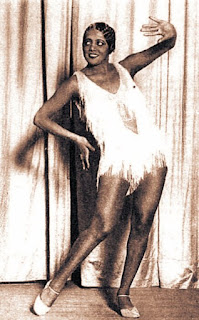(1904-19??)
Bessie Lankford or Bessie de Saussure, born around 1904, first appears in Chicago late-1922 in the Leonard Harper & Osceola Blanks's vaudeville revue "Plantation Days" at the Green Mills Garden. It was considered the rival of Lew Leslie's "Plantation Revue" already based in Harlem, and both were often confused. The show toured the United States early 1923, and appeared, although unsuccessfully, in London's Empire Theater during the spring. Upon returning to America, she joined Jimmy Cooper's "Black & White Revue", where she met and struck up a friendship with the New Orleans clarinet player, Sidney Bechet. The show toured the Columbia Burlesque Circuit and Canada until the end of 1924. Bessie, known at the time as Bessie de Sota, stood out in the show, for her 'Egyptian novelty dancing' (Belly-dancing).
During the summer of 1925, Bechet opened his own club in Harlem, Club Basha, and invited Bessie from Chicago to headline as the club's leading dancer. She was soon also dating Bechet's Jewish business partner, George. One night, the director of the Log Cabin Club wanted Bessie to dance for him. She refused and Bechet wanted her fired. Instead, after several weeks of fighting and threats, Bechet abandoned the club and traveled to Paris with the show, Revue Negre. Bessie and George took over the club until early 1926, when she joined the cast of Lew Leslie's "Blackbirds of 1926" and traveled to Paris.

The show opened on May 28, at the Restaurant-Theatre des Ambassadeurs where it was a huge sensation. Most of France’s top stars attended, including Josephine Baker, Maurice Chevalier, Sacha Guitry, Yvonne Vallee, and the Dolly Sisters. Florence Mills was the star attraction with Johnny Hudgins in blackface doing his comedy routine. Bessie was an old friend of Josephine Baker, as they were soon sharing an apartment and wondered through the city, 'looking at babies' and traveling after hours to the many nightclubs in the Montmartre. Soon "Blackbirds" moved over in July to the Theatre des Champs-Elysees, where Josephine Baker made her debut months earlier, before packing up and traveling to Antwerp, Belgium.
In September, Charles Cochran arranged for "Blackbirds" to appear in London, where Bessie remained until the show finally closed early 1927. While most of the cast returned home, Bessie traveled to France, where she toured with a small variety revue along the coast. The Afro-American newspaper stated she returned to Paris in September to appear with Mistinguett and Johnny Hudgins in "Ca..C'est Paris" at the Moulin Rouge. In the winter of 1928, Bessie opened in Berlin's Haus Vaterland, where she was booed off the stage for not being dark enough for the German audience. "We want a black American!" The manager had to escort her out the back door. She departed immediately for Hamburg, where she appeared at the Libelle Kabarett.
 |
| "Blackbirds" London (1926) |
Early 1929, Bessie was appearing in Prague, Budapest, Nüremburg and probably many other European capitals. Returning to Paris the following year, she was introduced to Surrealist poet, Robert Desnos, during an appearance the Bœuf Sur Le Toit restaurant and developed a brief affair before he married Lucie 'Youki' Badoud. While in Europe, Bessie's performances became more exotic as she performed under the name, Miss Bessie, la danseuse Cubaine (the Cuban dancer). During her appearances at the Melody-Bar, La Rumba and the Boule Blanche, Bessie danced the Rumba, Beguine and her usual bellydancing.
In the summer of 1933, while at the Hotel Liszeaux's Cafe, Bessie knocked out an white American woman who insulted her. When a friend of Bessie offered to help the woman, she yelled, "Take your Black hands of!". Afterwards Bessie knocked the woman out again. After leaving France in 1935, Bessie tours, briefly with a Spanish revue, into Czechoslovakia and Holland. She might have appeared other places with another stage name. She was back in Paris at the Cuban nightclub, La Pigall's, early 1938. Bessie returned to America that winter to appear in James P. Johnson's "Policy Kings" at the Nora Bayes Theatre. The show was given good reviews, but the public was uncomfortable with the show's comic treatment of Harlem's gangsters. The show only ran three performances. While in Harlem, she displayed her exotic dances for sculptor, Augusta Savage, at her home.
Afterwards Bessie dissappears, either settling in America or returning to Europe before the start of the war. She doesn't appear again until 1973, when Ada Bricktop Smith opened a new club where Bessie attended the opening.



